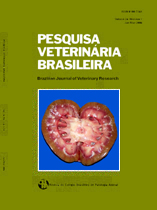 |
|
|
|
Year 2012 - Volume 32, Number 9
|

|
Molecular detection of enteropathogenic Escherichia coli in asymptomatic captive psittacines, 32(9):922-926
|
ABSTRACT.- Saidenberg A.B., Teixeira R.H.F., Guedes N.M.R., Allgayer M.C., Melvelville P.A. & Benites N.R. 2012. Molecular detection of enteropathogenic Escherichia coli in asymptomatic captive psittacines. Pesquisa Veterinária Brasileira 32(9):922-926. Departamento de Medicina Veterinária Preventiva, Faculdade de Medicina Veterinária e Zootecnia, Universidade de São Paulo, Av. Prof. Dr. Orlando Marques de Paiva 87, São Paulo, SP 05508-270, Brazil. E-mail: andresaidenberg@usp.br
Psittaciformes are one of the most endangered groups of birds, and several Brazilian species are classified between vulnerable and critically endangered. It is thus necessary to identify agents that cause infections in captive wild animals and to assess the risks posed thereof and to design interventions to minimize the possibility of disease outbreaks, leading to the conservation of endangered species. The purpose of this study was to identify enteropathogenic Escherichia coli (EPEC) cloacal isolates from asymptomatic psittacines in captivity and evaluate the distribution of the EPEC pathotype. Cloacal swabs were obtained from 46 asymptomatic birds, and resulting isolates were tested by polymerase chain reaction (PCR) for the presence of the attaching and effacing gene (eae) and bundle-forming pilus structural gene (bfpA) of EPEC. Samples from several species were tested, and three samples were found to be positive for the eae and bfpA genes and characterized as typical EPEC. This is the first report of this pathotype in asymptomatic psittacines. Although certain E. coli strains are more pathogenic than others, various factors should be considered when determining the potential of E. coli isolates to cause disease in captive psittacines. Birds that are positive for the EPEC (typical) strain could be zoonotic sources of infection, and may have acquired these strains through contact with humans or domestic animals. These findings may also be valuable for the long-term management of endangered species ex situ as one EPEC sample was isolated from a Red-tailed Amazon (Amazona brasiliensis). |
| |
|
|
| |
|
 |